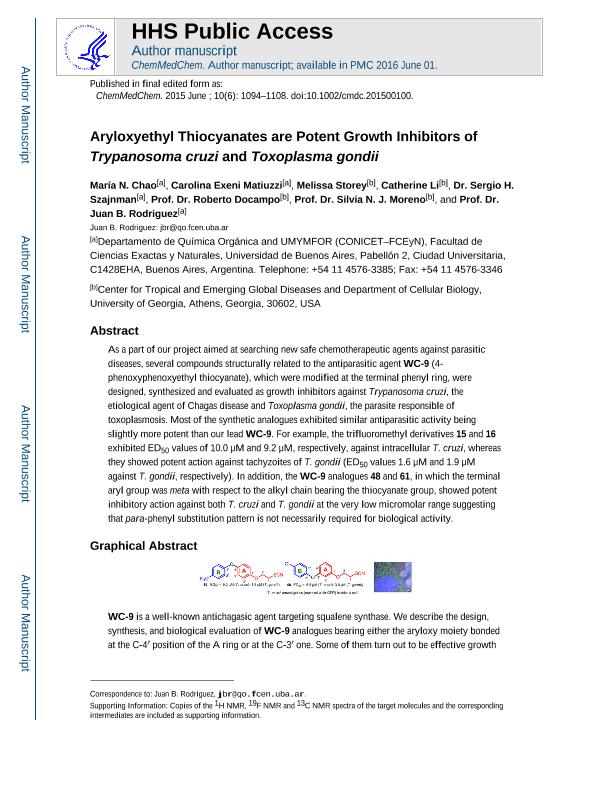Artículo
Aryloxyethyl thiocyanates are potent growth inhibitors of Trypanosoma cruzi and Toxoplasma gondii
Chao, Maria Noelia ; Exeni Matiuzzi, Carolina
; Exeni Matiuzzi, Carolina ; Storey, Melissa; Li, Catherine; Szajnman, Sergio Hernan
; Storey, Melissa; Li, Catherine; Szajnman, Sergio Hernan ; Docampo, Roberto; Moreno, Silvia N. J.; Rodriguez, Juan Bautista
; Docampo, Roberto; Moreno, Silvia N. J.; Rodriguez, Juan Bautista
 ; Exeni Matiuzzi, Carolina
; Exeni Matiuzzi, Carolina ; Storey, Melissa; Li, Catherine; Szajnman, Sergio Hernan
; Storey, Melissa; Li, Catherine; Szajnman, Sergio Hernan ; Docampo, Roberto; Moreno, Silvia N. J.; Rodriguez, Juan Bautista
; Docampo, Roberto; Moreno, Silvia N. J.; Rodriguez, Juan Bautista
Fecha de publicación:
03/2015
Editorial:
Wiley VCH Verlag
Revista:
Chemmedchem
ISSN:
1860-7179
Idioma:
Inglés
Tipo de recurso:
Artículo publicado
Clasificación temática:
Resumen
As a part of our project aimed at searching new safe chemotherapeutic agents against parasitic diseases, several compounds structurally related to the antiparasitic agent WC-9 (4-phenoxyphenoxyethyl thiocyanate), which were modified at the terminal phenyl ring, were designed, synthesized and evaluated as growth inhibitors against Trypanosoma cruzi, the etiological agent of Chagas disease and Toxoplasma gondii, the parasite responsible of toxoplasmosis. Most of the synthetic analogues exhibited similar antiparasitic activity being slightly more potent than our lead WC-9. For example, the trifluoromethyl derivatives 15 and 16 exhibited ED50 values of 10.0 uM and 9.2 uM, respectively, against intracellular T. cruzi, whereas they showed potent action against tachyzoites of T. gondii (ED50 values 1.6 uM and 1.9 uM against T. gondii, respectively). In addition, the WC-9 analogues 48 and 61, in which the terminal aryl group was meta with respect to the alkyl chain bearing the thiocyanate group, showed potent inhibitory action against both T. cruzi and T. gondii at the very low micromolar range suggesting that para-phenyl substitution pattern is not necessarily required for biological activity.
Palabras clave:
Trypanosoma Cruzi
,
Toxoplasma Gondii
,
Chagas Disease
,
Squalene Synthase
Archivos asociados
Licencia
Identificadores
Colecciones
Articulos(UMYMFOR)
Articulos de UNID.MICROANAL.Y MET.FISICOS EN QUIM.ORG.(I)
Articulos de UNID.MICROANAL.Y MET.FISICOS EN QUIM.ORG.(I)
Citación
Rodriguez, Juan Bautista; Moreno, Silvia N. J.; Docampo, Roberto; Szajnman, Sergio Hernan; Li, Catherine; Storey, Melissa; et al.; Aryloxyethyl thiocyanates are potent growth inhibitors of Trypanosoma cruzi and Toxoplasma gondii; Wiley VCH Verlag; Chemmedchem; 10; 6; 3-2015; 1094-1108
Compartir
Altmétricas



